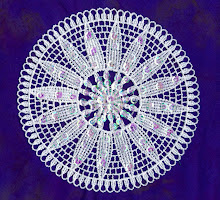Enriched bread, read this, do you feel enriched?
I sat staring at a loaf of bread yesterday, marveling about the current lo-carb fanaticism (please, people, keep eating your complex carbs, ok? It's just the simple carbs ya gotta cut down on). As I am currently in school for nutrition, I found myself perusing the nutritional content label, and there again seeing a host of evenly measured chemicallly extracted vitamins that are legally required to be added to every loaf of bread.
Maybe some of you don't know how bread is made. It is usually made from grain. Grain is a seed made up of three parts. The bran or hull is the tough outer layer that protects the grain. The germ is the heart, the life-giving part of the seed which would germinate by providing it's concentrated nutrients to create the first tiny portion of a plant. The endosperm is the starchy bulk, the center of the grain which nourishes the seedling before photosynthesis begins.
When commercial bread is made from grain, first the bran and the germ are removed. This is called refining, and removes a large portion of the nutrition in the grain, plus the regulating enzymes that would (if kept intact) allow the body to slowly process the grain into usable sugar. Without these, the body reacts to what is left as a simple starch, by providing a sudden lift in blood sugar, with no thrust from real nutrition to keep it going, hence the crash and cravings for more sugar, or bread. The micronutrients have been removed, leaving the macronutrients - carbohydrates, fat, and protein with no real nutritive value left in them.
In general, whole grains are rich in complex-carbs, protein, B vitamins, vitamin E, iron, zinc, magnesium, and dietary fiber. When refined they lose most B vitamins, vitamin E, unsaturated fatty acids, some protein. Due to this - it is required by U.S. law for breadmakers to "enrich" their breads. That is, add back some of the nutrients that were removed. Only 3 or 4 of the B vitamins and the iron are replaced. The replacements are not balanced, and they are synthetic - as they are adhering to laws about breadmaking, not the laws of nature.
So, in other words, to make bread one takes perfectly good grain, processes out most of the nutrition, and then adds a little back in, that little being almost completely biologically unavailable. This is enriching.
Would you find it enriching if you were mugged at gunpoint in the street, asked to strip naked, then given back someone else's shoes in the wrong size so you could walk home?
To make a healthy bread - soak and sprout your organic (to avoid loss of nutrition through bad soil and processing) whole grains, then slow bake them. The bread will end up a little bit moister than you are used to, and you'll find it's much more filling. By doing this, you are getting almost all the nutrients in the grain, save those that are lost by heating. Once you eat bread in this form, it will teach you how to eat it. You will not have the same cravings for sugar and simple starches. This bread cures your cravings for bread.
To learn how to make sproud bread check out: http://www.amazon.com/gp/reader/1878736868/ref=sib_dp_pt/102-3498758-8804138#reader-link
or "Sproutman's Kitchen Garden Cookbook" by Steve Meyerowitz


0 Comments:
Post a Comment
<< Home